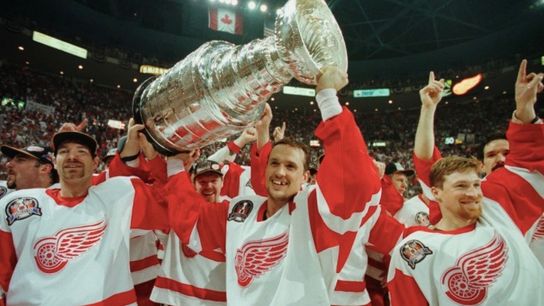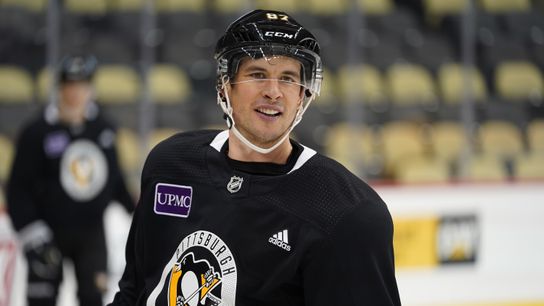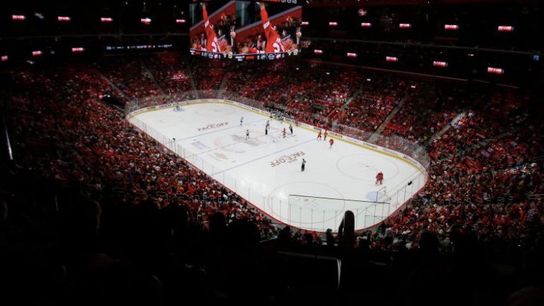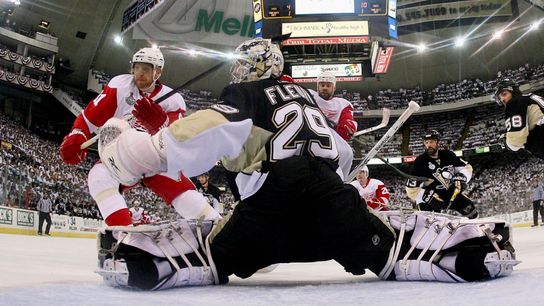COLUMBUS, Ohio — In the dying days of the empire, when even those who built it could see the decay, the Red Wings commissioned a commemorative logo to be displayed at center ice of old Joe Louis Arena.
The franchise was celebrating 25 consecutive seasons of Stanley Cup playoff participation in the spring of 2016 — which, at the time, represented the longest active streak among the major North American pro sports leagues. The emblem was not just showcased on the ice surface but also emblazoned on team merchandise.
The run of excellence took pride of place on a mantle that included four Stanley Cups, six conference championships and 14 division titles. But the stunning longevity came at a price, and some began to wonder if just squeaking into the playoffs each year was worth it. Iconic players were aging, and among the next generation there were no difference-makers on the roster or in the system.
Detroit had traded away high draft picks for veterans, and was never in a position to take a transformative prospect at the top of the draft board. By the time the Red Wings faced the Lightning in the opening round of the 2016 postseason, Nicklas Lidstrom was gone and Pavel Datsyuk and Henrik Zetterberg were not far behind.
“If you can’t replace those top, top players, you become ordinary,” said former Detroit general manager Jim Devellano, who still serves as a senior vice president and alternate governor. “We knew when they left, the lights were going to go out in Detroit.”
The Red Wings lost the series to Tampa Bay in five games. Their center-ice commemorative logo might as well have been a funeral wreath, as they have not returned to the playoffs since and, last season, finished with the worst points percentage (.275) since the 1999-2000 Atlanta Thrashers. While Detroit is rebuilding through the draft, the organization is nowhere close to competing for another Cup.
Nowadays, the longest active playoff streak in pro sports belongs to the franchise that denied the Red Wings their best shot at capturing a fifth Cup during that glorious stretch. The Penguins have qualified for the postseason 15 consecutive times and have won three titles in that span, including the 2009 Cup in seven games against the Wings.
They, too, boast three legendary players: Sidney Crosby, Evgeni Malkin and Kris Letang, who are in their mid-30s. They, too, are dealing with a string of disappointing early playoff exits. They, too, hear the whispers of critics wondering whether it’s time to rebuild even as management publicly commits to staying the course after winning a division title and finishing as the NHL's second highest-scoring team.
“I guess the sentiment is the same,” the Penguins' president of hockey operations, Brian Burke told DK Pittsburgh Sports’ Dave Molinari this week when asked about the similarities to the old Detroit core. “We respect what these guys have done here. We may be new (to our positions), but we respect what these three players have meant to the Pittsburgh Penguins. We've admired it from afar, and now we get to be part of it.”
The @penguins have clinched a playoff berth for a franchise-record 15th-straight season, which is the longest active postseason streak among all teams in the major North American professional sports leagues. pic.twitter.com/idwz6yHXky
— Penguins PR (@PenguinsPR) April 30, 2021
Since the 2004-05 NHL lockout, the Penguins, Blackhawks and Kings are the only teams to win multiple Cups. But the dominance of the Blackhawks and Kings was confined to a six-year window from 2010-16, and both franchises began missing the playoffs within a few years of their last title.
It’s why the Penguins’ most fitting comparison is to the Red Wings.
“There’s no one on this Earth who can relate to the Pittsburgh Penguins better than (former Detroit general manager) Kenny Holland and I because they are the Red Wings,” Devellano said. “They have had a terrific run— I believe three Cups — and the continuous playoff streak. Even this year, I thought they had a wonderful season, a real good season. Those three core players still have something left. But they have miles on their bodies, and it happens to everybody.”
The Penguins are entering a crucial offseason. It seems like an appropriate time to look back at the Red Wings and see what lessons can be gleaned from the rise and fall of a storied franchise. Some of the points raised here will appear contradictory, illustrating the fine line organizations walk when trying to sustain success.
“Once you have it,” former Detroit goaltender Manny Legace said, “you don’t want to let go of it.”
DON’T BE STUBBORN
In the spring of 2013, it appeared the Red Wings might turn back time again as they had a decade earlier when raising a banner for one of the oldest Stanley Cup champions in history.
A season after Lidstrom’s retirement, they beat the Ducks in the opening round and raced to a 3-1 series lead over the Blackhawks. If they could upset Patrick Kane and Jonathan Toews, a path to an unlikely title looked realistic. Chicago rallied to win three straight, however, including a 2-1 overtime victory in Game 7.
The painful postseason elimination should have convinced management the Red Wings’ championship window had closed, one source close to the team said, and that it was time to embark on a rebuild.
The Red Wings jettisoned their first-round pick eight times from 2001 to 2012. They re-acquired defenseman Kyle Quincey in a three-team deal at the 2012 trade deadline that involved the Avalanche and Lightning. Why is that one noteworthy? Tampa Bay used the first rounder it received from Detroit to select future Vezina Trophy winner Andrei Vasilevskiy.
“We knew when we were doing it— just as Jimmy Rutherford knew it— that it was going to bite you in the ass down the road,” Devellano said of moving high picks for veteran players.
The Red Wings have kept all their first-rounders since 2013, but it didn’t stop them from enlisting aging stars in an effort to remain competitive. In 2010, they signed 40-year-old future Hall-of-Famer forward Mike Modano. Four years later, the Red Wings added two-time Cup winner Brad Richards at age 35.
Several sources close to the organization said the Red Wings grew stubborn in their talent acquisition. While Holland and management drew much of the criticism, sources indicate ownership was hellbent on extending the playoff streak even as it became obvious the days of deep postseason runs were over.
In the pre-salary cap era, the Red Wings’ patriarch, Mike Ilitch, who died in 2017, never hesitated to open his checkbook to secure the best talent. It's how the they fielded a roster with nine future Hall of Famers and coach Scotty Bowman for the 2002 Cup triumph.
One of the franchise’s proudest achievements, however, was staying in title contention after the cap was instituted following the 2004-05 lockout.
“When the hard cap came into existence, Kenny Holland and I had two general managers, who are still in the league, tell us, ‘You guys will go under now. The cap is really going to bite you in the ass,’ ” Devellano recalled. “We sort of believed them, but guess what? We went on for another 10 years.”
The Red Wings were ahead of the curve in placing heavy emphasis on puck possession and European scouting.
They introduced the hockey world to the “Russian Five” led by Sergei Fedorov. They mined late-round gems such as Datsyuk (sixth round, 1998) and Zetterberg (seventh round, 1999) and turned the last player chosen in the 2002 draft, Jonathan Ericsson (ninth round), into a 13-year mainstay on the blue line.
“Without Zetterberg and Datsyuk, the streak is probably over after 15 years,” Devellano said.
But the Red Wings began to run out of draft luck and ingenuity, the prospect pipeline slowing to a trickle. For every Johan Franzen, there were four or five Thomas McCulloms.
“When you make the playoffs that many times in a row, you never really get a shot at an early draft pick,” Devellano said. “We never drafted in the top 20 for 25 years, and we also traded a lot of high draft picks to get patches to keep us in contention. The Penguins have been on that path, too. They haven’t drafted high enough to get a shot at another Crosby type of payer.”

GETTY
Steve Yzerman, center, led the Red Wings to three Stanley Cups.
FOLLOW THE LEADERS
Legace knew all about Steve Yzerman’s leadership qualities on the ice and in the dressing room. In the spring of 2002, the former Red Wings’ goaltender discovered his captain’s motivational tactics even extended to the sauna. He had just signed his first million-dollar deal at age 28. He was excited to share the news, but told nobody. The ink was barely dry on the contract when Yzerman entered the sauna and sat down next to him.
"Stevie comes in and says, ‘Congratulations on the new deal,' " recalled Legace, a member of the 2002 Cup team that featured nine players 35 years and older. "I’m like, ‘How do you know?’ He looks at me and says, ‘Manny, I know everything that goes on with this team.’ Stevie says, ‘First time you got one million, right? What’s it gonna take to get two million?’
“It was message sent and message received. That’s why he was the captain. He put me right back into the mindset of, ‘You can’t be satisfied with this. You got to start working toward your next goal.”
Leadership was a vital component to the Red Wings’ playoff streak. It started with Yzerman and worked its way through the lineup. Other stars like Brendan Shanahan and Chris Chelios were instrumental in setting the tone, but so were grinders such as Kris Draper and Kirk Maltby.
“Not everybody is a leader, but there has to be accountability throughout the whole team,” Legace said. “That’s what we had with those teams. It allowed us to bring in a guy like Brett Hull, who might have been a bit of a (free spirit), but he just fell in line and was a great teammate.”
That level of expectation was passed along through generations with the Red Wings.
“You felt the excellence there in Detroit,” said former NHL enforcer Jody Shelley, who now serves as an analyst for the NHL Network and the Blue Jackets. “First, it was Yzerman. Then, it was Lidstrom. And then it was Zetterberg and Datsyuk.”

PENGUINS
Sidney Crosby in training camp.
Shelley believes the Penguins also have one of the league’s elite leaders in Crosby. The analyst understands why Pittsburgh’s new management team of Burke and Ron Hextall says it's keen on keeping the core three players intact, while adding some size to the roster.
Rebuilding is inevitable, but Shelley and others said retaining a talisman such a Crosby is important because of the universal respect he commands. If the Pittsburgh captain can stay in the lineup for a few more years, he can build a bridge to the next generation of Penguins.
“If you put me in a position where Crosby, Malkin and Letang are there with that experience, and you add some of players who can give Sid a little more room, I would not say the window is closed,” Shelley said.
LOYAL BUT NOT TO A FAULT
This summer, the Penguins have the opportunity to sign Malkin and Letang, unrestricted free agents after next season, to contract extensions. Management might be receptive to the idea, some speculate, if the players are willing to take pay cuts.
So here’s one of the contradictions we mentioned: How do you avoid the Red Wings' pitfalls if you don’t break up the core of stars in their mid-30s? These are the tricky crossroads that decision makers must navigate.
For years, a no-vacancy sign has hung on Bill Belichick’s door in regards to room for sentimentality. He’s repeatedly released players not named Tom Brady that helped him win Super Bowls.
The dynastic Red Wings were loyal to veterans who won Cups for them. It was an open secret stars like Yzerman, Lidstrom and Zetterberg would retire in Detroit, but the generosity extended beyond homegrown future Hall of Famers, and some say that’s where the Wings ran into trouble.
They signed 30-year-old defenseman Niklas Kronwall to a seven-year extension worth $33 million in 2011. They re-upped with 37-year-old forward Todd Bertuzzi for two seasons in 2012. They twice re-signed forward Dan Cleary to one-year deals well into his 30s.
Detroit is hardly alone when it comes to ignoring dates of birth. The Penguins gave the ageless Matt Cullen, who helped them win the 2016 Stanley Cup, a pair of one-year deals.
“The Red Wings’ veterans were treated very well by Mr. I,” a source said, referring to Ilitch. “But that can come back to hurt you sometimes, and it did with them in the later years.”

GETTY
Lots of empty seats in Little Caesars Arena in 2017.
CHERISH IT WHILE IT LASTS
Few NHL franchises have enjoyed the good fortune of being rotten at the right time more than the Penguins.
The club never touched bottom when the prize for suffering was Patrik Stefan, Nail Yakupov or Alexandre Daigle. The Penguins rebuilt their roster in the 2000s by taking Marc-Andre Fleury, Malkin and Crosby in consecutive years. Drafting Mario Lemieux in 1984 wasn’t a bad decision, either.
Even in the only season the Penguins missed the playoffs from 1989 to 2000, it enabled them to select Jaromir Jagr with the No. 5 overall pick in 1990.
It doesn’t always work that way. Just ask the Red Wings. They have had no lottery luck in the past five seasons, dropping back spots in the draft order four times, while merely holding their ground this year. The Wings are slated to choose sixth overall on July 23.
The Penguins’ prospect pool is even more shallow, and they don’t have a first-round pick this year due to the Jason Zucker trade. In fact, they select just twice in the first five rounds.
Pittsburgh has dealt its first-round pick in all but two years since 2012, and one of the selections, Kaspari Kapanen (2014), cost them a 2020 first-rounder to reacquire last summer.
Devellano’s advice: Ignore the looming iceberg and keep focused on surrounding Crosby with proven talent while he's still among the league’s best players.
“Oh, I would do it all over again,” Devellano said laughing. “It’s funny, we get criticized a lot in Detroit now. As we were hanging on, still making the playoffs, people would say, ‘The Red Wings are too old. Why don’t they blow it up?’ And here’s what I would tell the media when they would say that: ‘Fans are not going to like the rebuild. Trust me.’ Well, five years out, guess what? They don’t like it.”
Hextall developed his managerial reputation by taking a measured approach, playing the long game. He had the Flyers on the road to contention before being fired in 2018.
Organizational progress is rarely linear, however, and the Flyers took a drastic step back this season. Meanwhile, teams such as the Sabres have found themselves in an endless rebuilding loop and, for all their high-end talent, the Oilers and Maple Leafs can’t get out of the postseason’s early rounds.
“When I think about winning a Stanley Cup, I think about Tampa and Colorado and Boston,” Shelley said. “Then, I would say the Penguins could still compete to be a final-four team, but they have to make a few changes.”
These are uncertain times for the Penguins. Fans have needed only to glance at the sparse crowds in Little Caesars Arena, home to the Red Wings since 2017, to wonder if this is what the future holds in Pittsburgh. They also can gaze into the PPG Paints Arena rafters and remind themselves of the warm memories each of the five championship banners hold.
Devellano predicts the Penguins will fall short of matching the Red Wings’ 25-year playoff streak, but ...
“If I was running the team in Pittsburgh, I would be trying to make the playoffs in Year 16,” he said. “And people can complain, and that’s OK. Everyone is entitled to an opinion, no problem. But once you start missing, you don’t miss for one year. So while you have Crosby, while you have Malkin, while you have Letang, you keep patching and doing the best you can to keep a good team on the ice. Because when it’s over, it’s over. We’re living proof of it in Detroit.”

